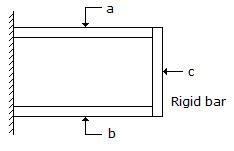Civil Engineering - Strength of Materials - Discussion
Discussion Forum : Strength of Materials - Section 3 (Q.No. 17)
17.
A composite member shown in below figure was formed at 25°C and was made of two materials a and b. If the coefficient of thermal expansion of a is more than that of b and the composite member is heated upto 45°C, then


Discussion:
13 comments Page 1 of 2.
Silence said:
6 years ago
Since the movement is restricted by the rigid support at C so both should be in compression.
(2)
Shah Sawar said:
4 years ago
The given answer is correct.
In composite members, both bars have to produce the same strain.
Now "a" bar due to its high coefficient of thermal expansion will tend to produce a higher strain than "b" bar and to fulfil the requirement of the same strain, tension is produced in "b" bar and compressive stresses in "a" bar.
In composite members, both bars have to produce the same strain.
Now "a" bar due to its high coefficient of thermal expansion will tend to produce a higher strain than "b" bar and to fulfil the requirement of the same strain, tension is produced in "b" bar and compressive stresses in "a" bar.
(1)
Shailendra kumar said:
9 years ago
If you add a line to maintain the equilibrium than option D is correct.
Ranjit ray said:
9 years ago
Tension in 'b' is due to quick elongation of 'a' because of high coeff. of thermal expansion.
Leo said:
8 years ago
Which material start deforming first? Which has a large coefficient of expansion or low coefficient of expansion? Please describe.
Kallan said:
8 years ago
The load is compressive. So the answer is correct.
Azzu said:
8 years ago
In composite members let A and B.
If the coefficient of thermal expansion of A is more than B.
Then, if temp rise occurs A subjected to compression and B will be subjected to tension.
If the coefficient of thermal expansion of A is more than B.
Then, if temp rise occurs A subjected to compression and B will be subjected to tension.
Jishan said:
8 years ago
Both bars try to elongate (b elongate less than that of a) but due to the rigid bar, their elongations are restricted thus a compression stress develop in both bar.
Shivam kamboj said:
7 years ago
I agree with @Jishan.
Option B is the right answer because it's a rigid bar.
Option B is the right answer because it's a rigid bar.
Aditya said:
7 years ago
Both A and B bars are fixed to the rigid bar C and due to the high temperature, they both try to elongate but due to the rigid bar they can't, so both the bars are under compression but bar A is under more compression because of its higher thermal coefficient.
Post your comments here:
Quick links
Quantitative Aptitude
Verbal (English)
Reasoning
Programming
Interview
Placement Papers